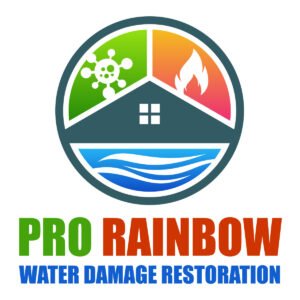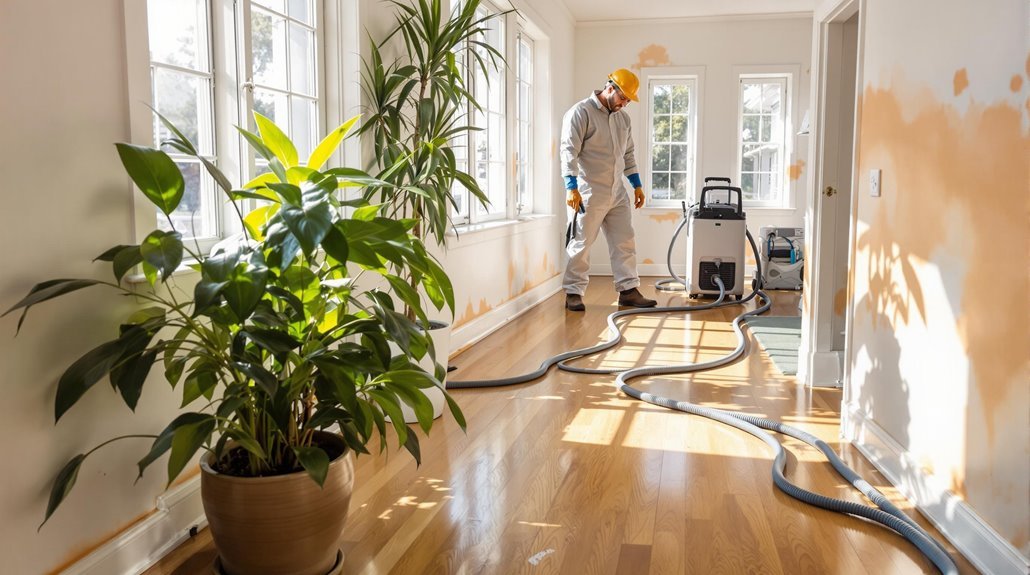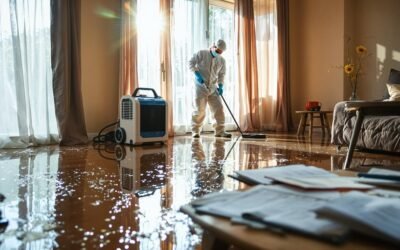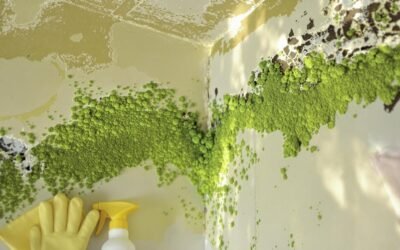Water damage restoration saves you money in the long run by addressing issues quickly, preventing costly repairs associated with mold growth and structural damage. Immediate action reduces health risks and financial burdens linked to prolonged exposure. Efficient restoration techniques, such as rapid drying and advanced monitoring, minimize the risk of deteriorating property value. Insurance benefits likewise play a role; timely restoration aligns with policy requirements, maximizing your coverage. By opting for professional help, you avoid expenses tied to overlooked issues. Understanding these financial implications not only protects your investment but additionally leads to better long-term outcomes. There's much more to uncover about these benefits.
Key Takeaways
- Timely restoration prevents extensive damage, reducing the need for costly repairs in the future.
- Addressing water damage quickly minimizes health risks, lowering potential medical expenses.
- Proper documentation of restoration efforts supports insurance claims, maximizing potential reimbursements.
- Regular maintenance and inspections catch issues early, preventing escalation and associated costs.
- Effective mold removal and humidity control reduce long-term health-related expenses and property damage.
Understanding Water Damage Costs
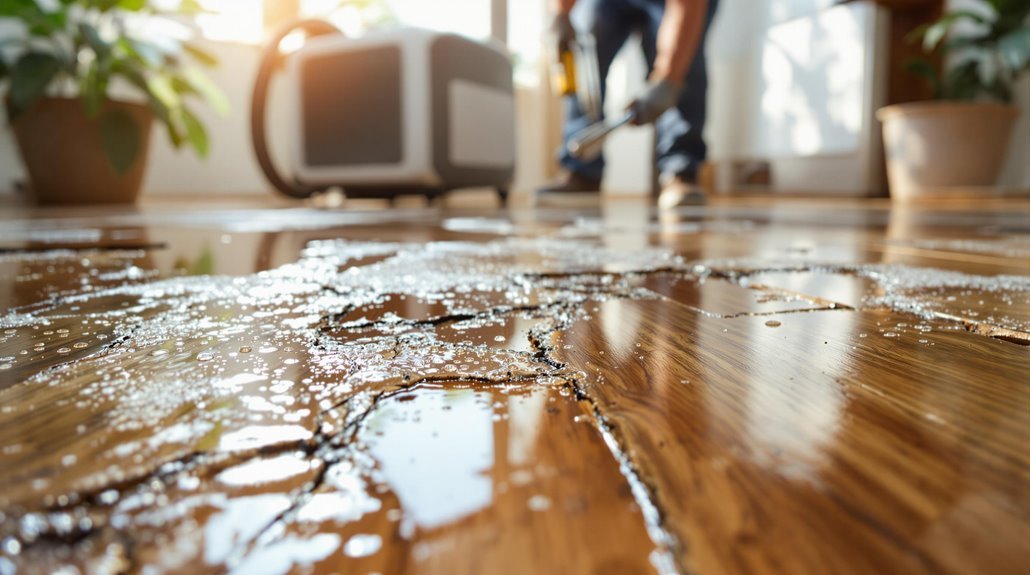
How do you gauge the costs associated with water damage restoration? Start by identifying the specific water damage types, such as clean water, grey water, or black water incidents. Each category carries different risks and remediation expenses. For instance, clean water damage usually incurs lower costs because of minimal contamination, whereas black water requires extensive decontamination, escalating expenses.
Next, conduct a thorough cost estimation that factors in materials, labor, and equipment needed for restoration. Consider additional elements like structural repairs and potential mold remediation, which can greatly influence the final bill. By understanding these components, you can make well-informed choices, ensuring that you're financially prepared for the restoration process while minimizing long-term damages to your property. Additionally, timely intervention can prevent mold growth and further damage, ultimately saving you more money in the long run.
The Importance of Quick Action
When water damage occurs, acting quickly is essential to prevent mold growth, which can develop within 24 to 48 hours. By addressing the issue promptly, you not only safeguard your health but likewise minimize repair costs, as extensive damage often leads to more expensive renovations. Prioritizing swift action can greatly impact the overall outcome of your restoration efforts. Furthermore, utilizing advanced equipment for water extraction can significantly reduce the time and cost associated with the restoration process.
#
Preventing Mold Growth
Although water damage can occur suddenly, the response time is essential in preventing mold growth. Mold spores are ubiquitous, and when moisture levels rise as a result of water damage, they can quickly proliferate, leading to significant health risks and structural damage. Acting swiftly to remove excess water and dry affected areas within 24 to 48 hours is critical. Failure to do so creates an environment that encourages mold development, as spores thrive in damp conditions. Utilize dehumidifiers and proper ventilation to control moisture levels effectively. Regular monitoring of humidity can likewise help mitigate risks. By prioritizing rapid intervention, you not only safeguard your health but likewise preserve your property's integrity, ultimately saving you from costly remediation efforts down the line.
Reducing Repair Costs
Timeliness is critical in minimizing repair costs following water damage. When you act quickly, you can considerably reduce the extent of damage, which lowers overall repair expenses. A thorough water damage assessment allows you to identify affected areas early, enabling targeted intervention. Utilizing effective restoration techniques, such as water extraction and dehumidification, prevents further deterioration of structural elements and reduces the likelihood of mold growth. Delaying these actions can lead to more extensive damage, requiring costly repairs or replacements. Furthermore, swift action not only saves money but also protects the integrity of your property. By prioritizing quick response and employing professional services, you're making a strategic investment that pays off in reduced repair costs and improved property value.
## Preventing Mold Growth
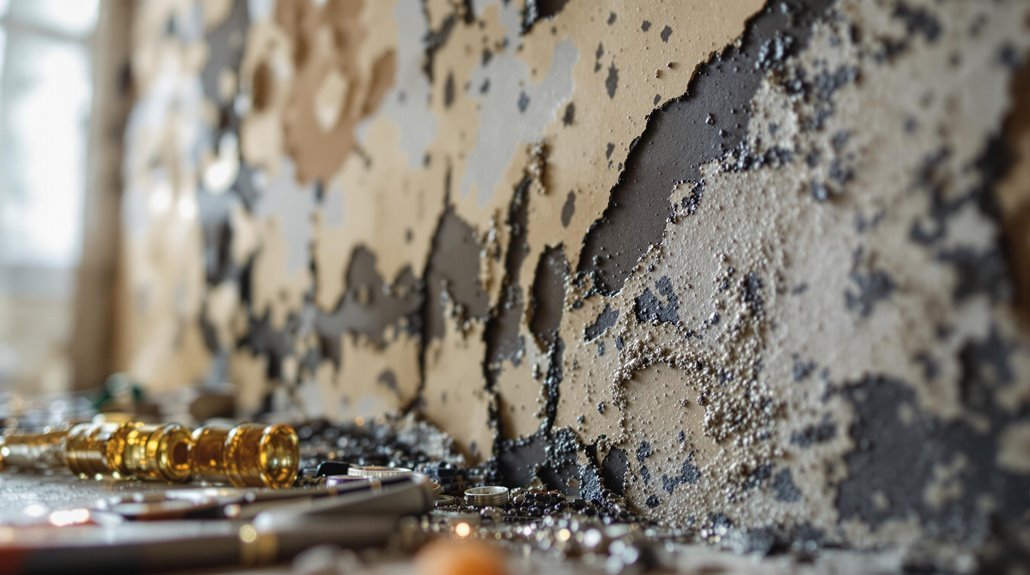
To effectively prevent mold growth after water damage, you must implement rapid drying techniques immediately. Controlling humidity levels is critical, as increased moisture can promote mold development. Furthermore, conducting regular inspections can help identify and mitigate any potential mold hotspots before they escalate.
Rapid Drying Techniques
Effective rapid drying techniques are crucial for preventing mold growth after water damage. Utilizing advanced technology, you can expedite the drying process, greatly reducing moisture levels. Here are three key methods to implement:
- Dehumidifiers: Using high-capacity dehumidifiers pulls excess moisture from the air, accelerating the drying of affected materials.
- Air Movers: Positioning air movers strategically increases airflow, promoting quicker evaporation of water from surfaces.
- Thermal Imaging: Employing thermal imaging technology helps identify hidden moisture pockets, ensuring no damp areas are overlooked.
Humidity Control Measures
While addressing water damage, implementing humidity control measures is vital for preventing mold growth. You should prioritize humidity monitoring to track moisture levels in your environment. Keeping relative humidity below 60% is fundamental, as this threshold inhibits mold proliferation. Utilize dehumidifiers to extract excess moisture from the air, particularly in damp areas.
Furthermore, consider installing moisture barriers in basements and crawl spaces to prevent groundwater infiltration. These barriers act as a protective layer, minimizing moisture exposure to structural elements. Regularly check and maintain your humidity control systems to guarantee they function effectively. By proactively managing humidity, you not only protect your property but additionally save on potential costly mold remediation in the future.
Regular Inspections Importance
Regular inspections are vital for identifying potential moisture issues before they escalate into significant mold problems. By conducting regular assessments and scheduled evaluations, you can proactively mitigate risks associated with water damage. Here are three key benefits of routine inspections:
- Early Detection: Identifying hidden leaks or damp areas allows you to address issues promptly, preventing mold growth.
- Cost Savings: Preventing mold development through timely action can save you from costly remediation efforts later on.
- Health Protection: Regular evaluations help guarantee a safe environment by reducing allergens and toxins associated with mold exposure.
Incorporating these practices into your maintenance routine not only safeguards your property but additionally improves your long-term financial stability. Invest in regular inspections to protect your investment effectively.
Reducing Structural Damage
To minimize structural damage, it's crucial to act swiftly once water intrusion occurs. Delaying the restoration process can compromise your property's foundation integrity and require costly structural reinforcement. Immediate action can help prevent mold growth, warping, and other issues that may weaken the building's framework.
Here's a breakdown of potential damages and their impacts:
| Type of Damage | Impact on Structure |
|---|---|
| Water Saturation | Compromised foundation integrity |
| Mold Growth | Structural weakening |
| Warping of Materials | Increased repair costs |
Insurance Benefits and Coverage
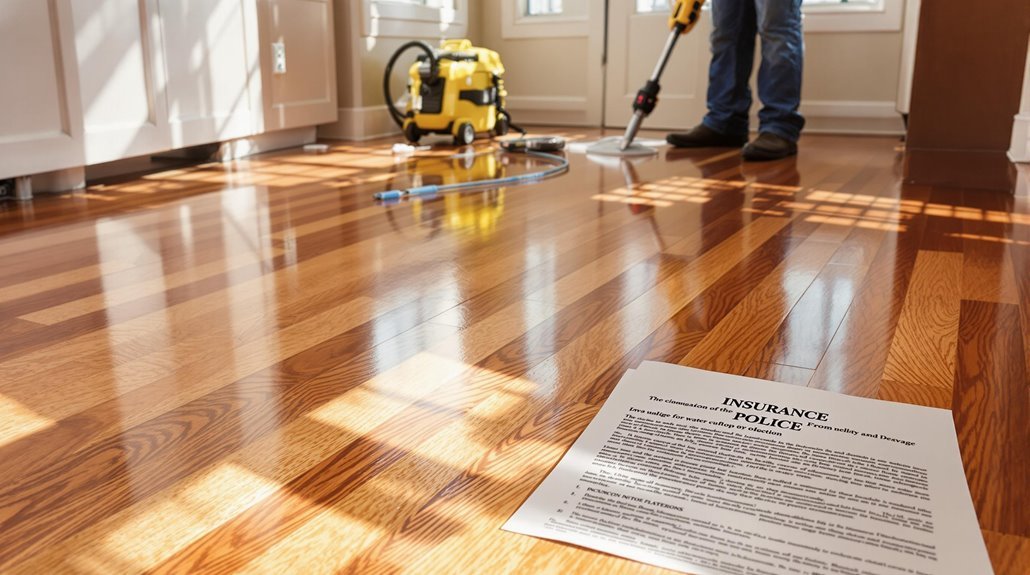
Taking immediate steps to address water damage not only preserves your property's integrity but likewise plays a significant role in your insurance coverage. Understanding your policy coverage can help you maximize your benefits during the claim process. Here are three key points to reflect upon:
- Timely Restoration: Prompt action often aligns with insurance requirements, ensuring your claim is valid.
- Document Everything: Keep records of damage, restoration efforts, and expenses to streamline the claim process.
- Consult Your Agent: Communicate with your insurance agent to clarify coverage details and any necessary steps you must take.
Long-Term Property Value
While water damage may seem like a temporary setback, neglecting its restoration can greatly diminish your property's long-term value. If you allow moisture issues to persist, structural integrity can be compromised, leading to costly repairs down the line. This deterioration negatively impacts property appraisal, as appraisers will consider visible damage and potential future issues. Ultimately, your home's resale value will suffer, making it harder to recover your investment. Buyers are often wary of properties with a history of water damage, fearing hidden problems. By investing in thorough restoration now, you're not just addressing immediate concerns; you're preserving and potentially enhancing your property's marketability and financial return in the future. Prioritize restoration to safeguard your investment.
Health Risks and Expenses
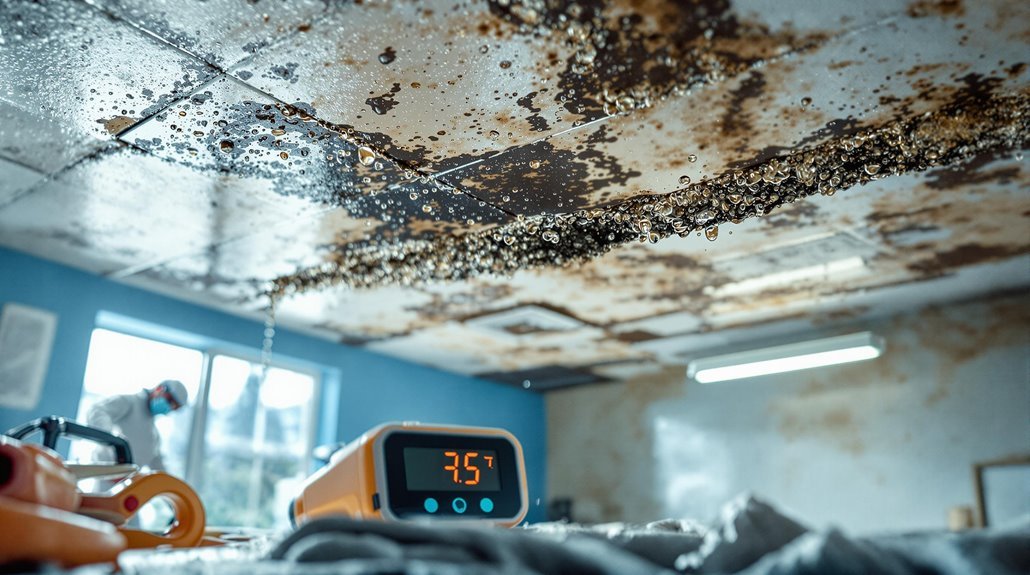
Ignoring water damage not only threatens your property's value but likewise poses significant health risks. Prolonged exposure to moisture can lead to serious health complications, ultimately resulting in higher financial burdens for you. Here are three major concerns:
- Mold Growth: This can trigger respiratory issues and allergic reactions, requiring costly medical treatment.
- Structural Integrity: Water damage can weaken your home's structure, leading to expensive repairs and increased insurance premiums.
- Pest Infestations: Damp environments attract pests, which can carry diseases and necessitate costly extermination services.
Addressing water damage promptly minimizes these health risks and associated expenses, ensuring a safer living environment and protecting your finances in the long run. Don't overlook the importance of timely restoration.
DIY vs. Professional Restoration
When it comes to water damage restoration, should you tackle the problem yourself or hire a professional? While DIY restoration might seem cost-effective, it often leads to significant DIY pitfalls. You might overlook hidden moisture, leading to mold growth and structural damage, which can escalate repair costs. In addition, renting equipment and purchasing materials can add up quickly.
On the other hand, professional restoration offers distinct advantages. Trained experts utilize advanced technology to assess damage accurately, ensuring thorough restoration. They can efficiently manage hazardous materials, reducing health risks. Furthermore, their experience translates into faster, more effective solutions, ultimately saving you time and money. Weighing these factors is essential in making the right decision for your property.
Maintenance and Prevention Tips

To effectively prevent water damage, it's vital to adopt a proactive maintenance strategy that addresses potential vulnerabilities in your property. Seasonal maintenance and regular cleaning are key components of this strategy. Here are three critical tips to implement:
- Inspect and clean gutters: Verify that your gutters are free from debris to prevent overflow, which can lead to foundation issues.
- Check plumbing regularly: Look for leaks and signs of wear around pipes, faucets, and fixtures. Fix any issues promptly to mitigate risks.
- Test sump pumps: Regularly check your sump pump's functionality, especially before heavy rainfall. This helps protect against potential flooding.
Real-Life Savings Examples
Understanding real-life savings from water damage restoration can greatly impact your finances. By preventing structural damage and reducing mold growth, you not only improve the durability of your property but additionally minimize potential repair costs. Analyzing these factors helps you make educated choices that can lead to substantial long-term savings.
Preventing Structural Damage
While water damage can wreak havoc on your property, taking proactive measures can save you significant costs in structural repairs. Addressing issues early on helps maintain your foundation integrity and prevents costly water ingress. Here are three effective strategies:
- Regular Inspections: Conduct routine checks for leaks and cracks in walls and foundations, catching problems before they escalate.
- Proper Drainage: Make sure that gutters and downspouts direct water away from your home to minimize the risk of foundation damage.
- Sealing Vulnerabilities: Inspect and seal windows, doors, and other entry points to prevent water from infiltrating your structure.
Reducing Mold Growth
Ignoring water damage can lead to mold growth, which poses health risks and further damages your property. Effective water damage restoration not only prevents mold but likewise saves you money through timely mold removal. By ensuring proper air circulation and addressing moisture, you create an environment that inhibits mold development.
Here's a breakdown of potential savings:
| Action Taken | Cost of Action | Potential Savings |
|---|---|---|
| Professional Mold Removal | $2,000 | Avoid health issues & property damage |
| Improved Air Circulation | $500 | Reduces mold risk and related repairs |
| Regular Inspections | $300 | Early detection prevents extensive damage |
Investing in these actions can markedly reduce long-term expenses associated with mold and structural damage.
Minimizing Repair Costs
When you proactively address water damage, you can greatly minimize repair costs and avoid extensive financial burdens down the line. Implementing cost effective solutions early on saves you from higher expenses later. Here are three real-life examples:
- Prompt Drying: Utilizing advanced restoration techniques like industrial dehumidifiers can prevent structural damage, saving thousands in repairs.
- Mold Prevention: Addressing moisture quickly reduces the risk of mold growth, which can lead to costly remediation and health issues.
- Insurance Benefits: Timely water damage restoration may result in lower premiums, as insurers recognize your proactive measures.
Conclusion
In the intricate movement of homeownership, swift water damage restoration is your timely partner, leading you away from escalating costs and health hazards. By acting quickly, you're not just salvaging your property; you're investing in its future. Think of it as patching a small leak before it becomes a gushing torrent. With the right steps, you'll not just save money but likewise guarantee your home remains a safe haven, standing strong against the unpredictable forces of nature.
